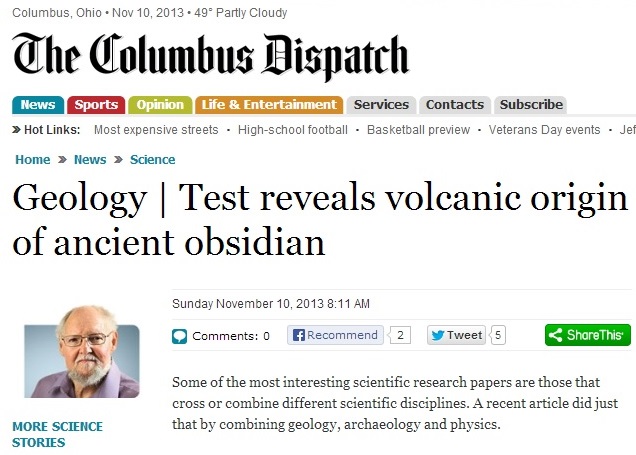 There are many paths to knowledge about our past and you never know which path will lead to a key insight. So archaeologists work with scientists in a variety of disciplines, from astronomy to zoology and just about everything in between. On various projects I have worked closely with geologists, geochemists, soil scientists, paleontologists, microbiologists, paleobotanists, biological anthropologists, geographers, physicists and, yes, astronomers and zoologists. This is what we mean when we say that archaeology is an interdisciplinary science. Dale Gnidovec, Curator of the Orton Geological Museum at the Ohio State University, provides a good example of this in his Sunday column in the Columbus Dispatch. He discusses a new technique for identifying the chemical “fingerprint” of obsidian developed by physicists, which is allowing archaeologists to know where the prehistoric people of Turkey and Syria obtained the obsidian they used to make their stone tools.
There are many paths to knowledge about our past and you never know which path will lead to a key insight. So archaeologists work with scientists in a variety of disciplines, from astronomy to zoology and just about everything in between. On various projects I have worked closely with geologists, geochemists, soil scientists, paleontologists, microbiologists, paleobotanists, biological anthropologists, geographers, physicists and, yes, astronomers and zoologists. This is what we mean when we say that archaeology is an interdisciplinary science. Dale Gnidovec, Curator of the Orton Geological Museum at the Ohio State University, provides a good example of this in his Sunday column in the Columbus Dispatch. He discusses a new technique for identifying the chemical “fingerprint” of obsidian developed by physicists, which is allowing archaeologists to know where the prehistoric people of Turkey and Syria obtained the obsidian they used to make their stone tools. 
Selection of obsidian artifacts from Ohio Hopewell sites. Image from the Ohio Historical Society’s “Virtual First Ohioans” online exhibit.